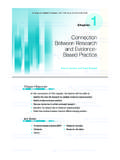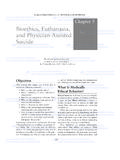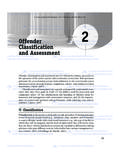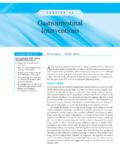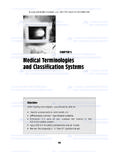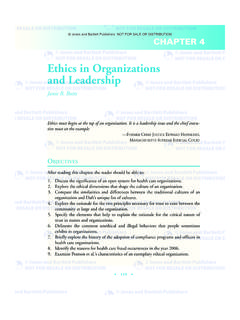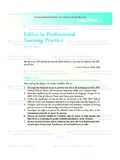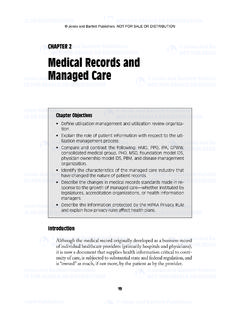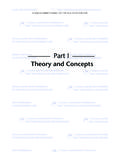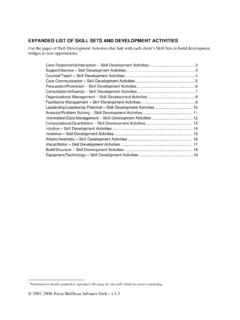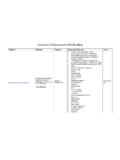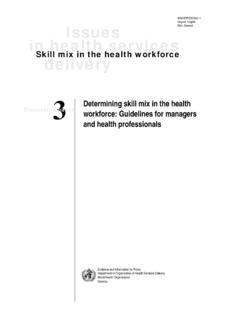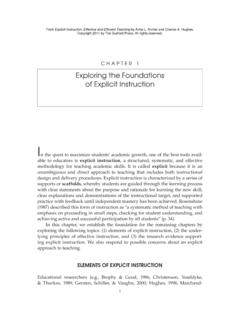Transcription of National Registry Skill Sheets - Jones & Bartlett …
1 National Registry Skill SheetsAirway, Oxygen and Ventilation skills /Upper Airway Adjuncts and SuctionBag-Valve-Mask/Apneic PatientBleeding Control/Shock ManagementCardiac Arrest Management/AEDI mmobilization skills /Joint InjuryImmobilization skills /Long Bone Injury Immobilization skills /Traction SplintingMouth to Mask With Supplemental OxygenOxygen AdministrationPatient Assessment/Management MedicalPatient Assessment/Management TraumaSpinal Immobilization/Seated PatientSpinal Immobilization/Supine PatientVentilatory Management/Dual Lumen Device Insertion Following an UnsuccessfulEndotracheal Intubation AttemptVentilatory Management/Endotracheal IntubationVentilatory Management/Esophageal
2 Obturator Airway Insertion Following anUnsuccessful Endotracheal Intubation AttemptEmergency Care and Transportation of the Sick and Injured, Ninth EditionNational Registry Skill SheetsAirway, Oxygen and Ventilation SkillsUpper Airway Adjuncts and SuctionPoints Points PossibleAwardedOROPHARYNGEAL AIRWAYT akes, or verbalizes, body substance isolation precautions1 Selects appropriately sized airway1 Measures airway1 Inserts airway without pushing the tongue posteriorly1 Note: The examiner must advise the candidate that the patient is gagging and becoming consciousRemoves the oropharyngeal airway1 SUCTIONNote: The examiner must advise the candidate to suction the patient s airwayTurns on/prepares suction device1 Assures presence of mechanical suction1 Inserts the suction tip without suction1 Applies suction to the oropharynx/nasopharynx1 NASOPHARYNGEAL AIRWAYNote: The examiner must advise the candidate to insert a nasopharyngeal airwaySelects appropriately sized airway1 Measures airway1 Verbalizes lubrication of the nasal airway1 Fully inserts the airway with the bevel facing toward the septum1 TOTAL:13 Start Time: Date:Stop Time:Candidate s Name:Evaluator s Name.
3 Did not take, or verbalize, body substance isolation precautionsDid not obtain a patent airway with the oropharyngeal airwayDid not obtain a patent airway with the nasopharyngeal airwayDid not demonstrate an acceptable suction techniqueInserted any adjunct in a manner dangerous to the patientCRITICAL CRITERIAE mergency Care and Transportation of the Sick and Injured, Ninth EditionNational Registry Skill SheetsBag-Valve-MaskApneic PatientPoints Points PossibleAwardedTakes, or verbalizes, body substance isolation precautions1 Voices opening the airway1 Voices inserting an airway adjunct1 Selects appropriately sized mask1 Creates a proper mask-to-face seal1 Ventilates patient at no less than 800 ml volume(The examiner must witness for at least 30 seconds)1 Connects reservoir and oxygen1 Adjusts liter flow to 15 liters/minute or greater1 The examiner indicates arrival of a second EMT.
4 The second EMT is instructed to ventilate the patient while the candidate controls the mask and the airwayVoices re-opening the airway1 Creates a proper mask-to-face seal1 Instructs assistant to resume ventilation at proper volume per breath1(The examiner must witness for at least 30 seconds)TOTAL:11 Start Time: Date:Stop Time:Candidate s Name:Evaluator s Name:Did not take, or verbalize, body substance isolation precautionsDid not immediately ventilate the patientInterrupted ventilations for more than 20 secondsDid not provide high concentration of oxygenDid not provide, or direct assistant to provide, proper volume/breath(more than two (2) ventilations per minute are below 800 ml)
5 Did not allow adequate exhalationCRITICAL CRITERIAE mergency Care and Transportation of the Sick and Injured, Ninth EditionNational Registry Skill SheetsBleeding Control/Shock ManagementPoints Points PossibleAwardedTakes, or verbalizes, body substance isolation precautions1 Applies direct pressure to the wound1 Elevates the extremity1 Note: The examiner must now inform the candidate that the wound continues to an additional dressing to the wound1 Note: The examiner must now inform the candidate that the wound still continues to bleed. The second dressing does not control the and applies pressure to appropriate arterial pressure point1 Note: The examiner must now inform the candidate that the bleeding is controlledBandages the wound1 Note: The examiner must now inform the candidate the patient is now showing signs and symptoms indicative of hypoperfusionProperly positions the patient1 Applies high concentration oxygen1 Initiates steps to prevent heat loss from the patient1 Indicates the need for immediate transportation1 TOTAL:10 Start Time: Date:Stop Time:Candidate s Name:Evaluator s Name.
6 Did not take, or verbalize, body substance isolation precautionsDid not apply high concentration of oxygenApplied a tourniquet before attempting other methods of bleeding controlDid not control hemorrhage in a timely mannerDid not indicate a need for immediate transportationCRITICAL CRITERIAE mergency Care and Transportation of the Sick and Injured, Ninth EditionNational Registry Skill SheetsCardiac Arrest Management/AEDWith Bystander CPR inProgressPointsPointsPossibleAwardedASS ESSMENTT akes, or verbalizes, body substance isolation precautions1 Briefly questions the rescuer about arrest events1 Turns on AED power1 Attached AED to the Patient1 Directs rescuer to stop CPR and ensures all individuals are clear of the patient1 Initiates analysis of the rhythm1 Delivers shock1 Directs resumption of CPR1 TRANSITION1 Gathers additional information about arrest event1 Confirms effectiveness of CPR (ventilation and compressions)1 INTEGRATIONV erbalizes or directs insertion of a simple airway adjunct (oral/nasal airway)
7 1 Ventilates, or directs ventilation of, the patient1 Assures high concentration of oxygen is delivered to the patient1 Assures adequate CPR continues without unnecessary/prolonged interruption1 Continues CPR for 2 minutes1 Directs rescuer to stop CPR and ensures all individuals are clear of the patient1 Initiates analysis of the rhythm1 Delivers shock1 Directs resumption of CPR1 TRANSPORTATIONV erbalizes transportation of patient1 TOTAL:20 Start Time: Date:Stop Time:Candidate s Name:Evaluator s Name:Did not take, or verbalize, body substance isolation precautionsDid not evaluate the need for immediate use of the AEDDid not immediately direct initiation/resumption of ventilation/compressions at appropriate timesDid not assure all individuals were clear of patient before delivering each shockDid not operate the AED properly (inability to deliver shock)Prevented the defibrillator from delivering indicated stacked shocksCRITICAL 6/27/07 8.
8 47 AM Page 5 Emergency Care and Transportation of the Sick and Injured, Ninth EditionNational Registry Skill SheetsImmobilization SkillsJoint InjuryPoints Points PossibleAwardedTakes, or verbalizes, body substance isolation precautions1 Directs application of manual stabilization of the shoulder injury1 Assesses motor, sensory and circulatory function in the injured extremity1 Note: The examiner acknowledges motor, sensory and circulatory function are present and normal. Selects the proper splinting material1 Immobilizes the site of the injury1 Immobilizes the bone above the injured joint1 Immobilizes the bone below the injured joint1 Reassesses motor, sensory and circulatory function in the injured extremity1 Note: The examiner acknowledges motor, sensory and circulatory function are present and normal.
9 TOTAL:8 Start Time: Date:Stop Time:Candidate s Name:Evaluator s Name:Did not support the joint so that the joint did not bear distal weightDid not immobilize the bone above and below the injured siteDid not reassess motor, sensory and circulatory function in the injured extremity before and after splintingCRITICAL CRITERIAG rossly moves the injured extremityDid not immobilize the joint above and the joint below the injury siteDid not reassess motor, sensory and circulatory function in the injured extremity before and after splintingCRITICAL CRITERIAE mergency Care and Transportation of the Sick and Injured, Ninth EditionNational Registry Skill SheetsImmobilization SkillsLong Bone InjuryPoints Points PossibleAwardedTakes, or verbalizes, body substance isolation precautions1 Directs application of manual stabilization of the injury1 Assesses motor, sensory and circulatory function in the injured extremity1 Note.
10 The examiner acknowledges motor, sensory and circulatory function are present and normal Measures the splint1 Applies the splint1 Immobilizes the joint above the injury site1 Immobilizes the joint below the injury site1 Secures the entire injured extremity1 Immobilizes the hand/foot in the position of function1 Reassesses motor, sensory and circulatory function in the injured extremity1 Note: The examiner acknowledges motor, sensory and circulatory function are present and normal TOTAL:10 Start Time: Date:Stop Time:Candidate s Name:Evaluator s Name:Emergency Care and Transportation of the Sick and Injured, Ninth EditionNational Registry Skill SheetsImmobilization SkillsTraction SplintingPoints Points PossibleAwardedTakes, or verbalizes, body substance isolation precautions1 Directs application of manual stabilization of the injured leg1 Directs the application of manual traction1 Assesses motor, sensory and circulatory function in the injured extremity1 Note.
